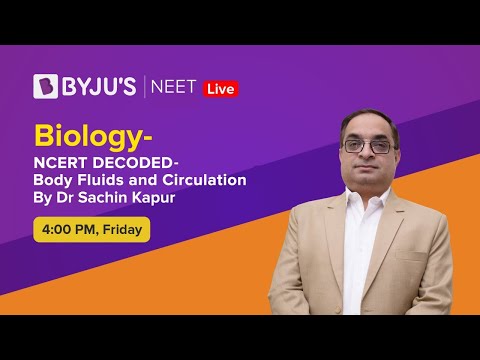Flashcards for NEET Biology are designed to boost your NEET preparation. Find below flashcards for Body Fluids and Circulation. These flashcards on Body Fluids and Circulation are prepared as per the NEET syllabus. This is helpful for aspirants of NEET and other exams during last-minute revision. Flashcards For NEET Biology – Body Fluids and Circulation, covers all the important points that are frequently asked in the exam. Check BYJU’S for the full set of Flashcards and Study material for NEET Biology. Solve NEET Biology MCQs to check your understanding and outperform in the exam.

Download PDF of NEET Biology Flashcards for Body Fluids and Circulation
| Plasma | 55% of blood
Contains- water (90-92%), Proteins (fibrinogen, albumins, globulins), minerals, glucose, lipids, amino acids, blood clotting factor |
| Serum | Plasma without the clotting factors |
| Formed elements | 45% of blood
Includes- Erythrocytes (RBC), Leucocytes (WBC) and Platelets |
| RBC | Biconcave and without a nucleus, 5-5.5 million per cubic metre of blood
Hb- 12-16 g/dl of blood Average lifespan 120 days Graveyard of RBC- spleen |
| WBC | Have nucleus, 6000-8000 per cubic metre of blood
Granulocytes and agranulocytes |
| Granulocytes | Neutrophils (60-65%)- phagocytic
Eosinophils (2-3%)- allergic reactions Basophils (0.5-1%)- secrete histamine, serotonin, heparin, involved in inflammatory reactions |
| Agranulocytes | Monocytes (6-8%)- phagocytic
Lymphocytes (20-25%)- B and T, involved in the immune response |
| Thrombocytes | Platelets, 1,500,00-3,500,00 per cubic metre of blood
Involved in blood clotting |
| Lymph | Tissue fluid and contains lymphocytes
Fat is absorbed through lacteals Transports, nutrients, hormones and involved in immune response. |
| Open circulatory system | Blood flows through open spaces called sinuses
E.g. Arthropods, Molluscs |
| Closed circulatory system | Blood flows through a closed network of blood vessels
E.g. Annelids, Vertebrates |
| Circulation in fishes | Single circulation
Two chambered heart, 1-atrium, 1-ventricle |
| Incomplete double circulation | In amphibians and reptiles, except crocodiles
Three chambered heart, 2-atria, 1-ventricle |
| Double circulation | In crocodiles, aves and mammals
Four chambered heart, 2-atria, 2-ventricles |
| Human heart | Origin- mesodermal
Four chambered and enclosed in the pericardium Left atrium and ventricle- oxygenated blood Right atrium and ventricle- deoxygenated blood |
| Tricuspid valve | Between right atrium and right ventricle
Produces ‘lub’ sound at the time of closure |
| Bicuspid valve | Mitral valve
Present between the left atrium and left ventricle Produces ‘lub’ sound at the time of closure |
| Semilunar valve | Present between- right ventricle and pulmonary artery, left ventricle and aorta
Produces ‘dub’ sound at the time of closure |
| SA node | Sino-atrial node
Present in the right atrium at the upper right corner Pacemaker of heart, generates action potential or impulses (70-75/min) |
| AV node | Atrio-ventricular node
Present in the right atrium at the lower left corner |
| Cardiac output | The volume of blood pumped by each ventricle- 5 l/min (70 ml in each cardiac cycle) |
| P-wave in ECG | Excitation or depolarisation of atria
Leads to the initiation of contraction of atria |
| QRS complex in ECG | Excitation or depolarisation of ventricles
Leads to initiation of contraction of ventricles Number of QRS complex help in determining the heartbeats per minute |
| T-wave in ECG | Repolarisation of ventricles and end of systole |
| Tunica externa | Outer layer of arteries and veins, made up of fibrous connective tissues and collagen fibres |
| Tunica media | Middle layer of arteries and veins, made up of smooth muscles and elastic fibres
Thin in veins |
| Tunica intima | Inner lining of arteries and veins, made up of squamous endothelium |
| Pulmonary circulation | Deoxygenated blood from right ventricle goes to lungs by pulmonary artery and then oxygenated blood from lungs comes to left atrium by pulmonary vein |
| Systemic circulation | Oxygenated blood from left ventricle goes to aorta and to tissues by arteries and then deoxygenated blood from tissues are brought back to right atrium by veins and vena cava |
| Hepatic portal system | Hepatic portal vein carries blood from digestive tract to liver before going to systemic circulation |
| Myogenic heart | Autoregulation of normal heart activities, i.e. rhythmic contractions originate intrinsically |
| Neural regulation of cardiac activity | Under the autonomic nervous system (ANS) control
Cardiac centres in medulla oblongata moderate heart activity Sympathetic nerves- increase heartbeat and cardiac output Parasympathetic nerves- decrease heartbeat and cardiac output |
| Hormonal regulation of cardiac activity | Adrenal medullary hormones epinephrine and norepinephrine increase the heartbeat |
Also Check:
NEET Flashcards: Breathing And Exchange Of Gases
NEET Flashcards: Excretory Products And Their Elimination
NEET Flashcards: Locomotion And Movement
NEET Flashcards: Neural Control And Coordination
NEET Flashcards: Chemical Coordination And Integration
Recommended Video:

Get access to the full set of flashcards for NEET Biology, only at BYJU’S.











I love this study